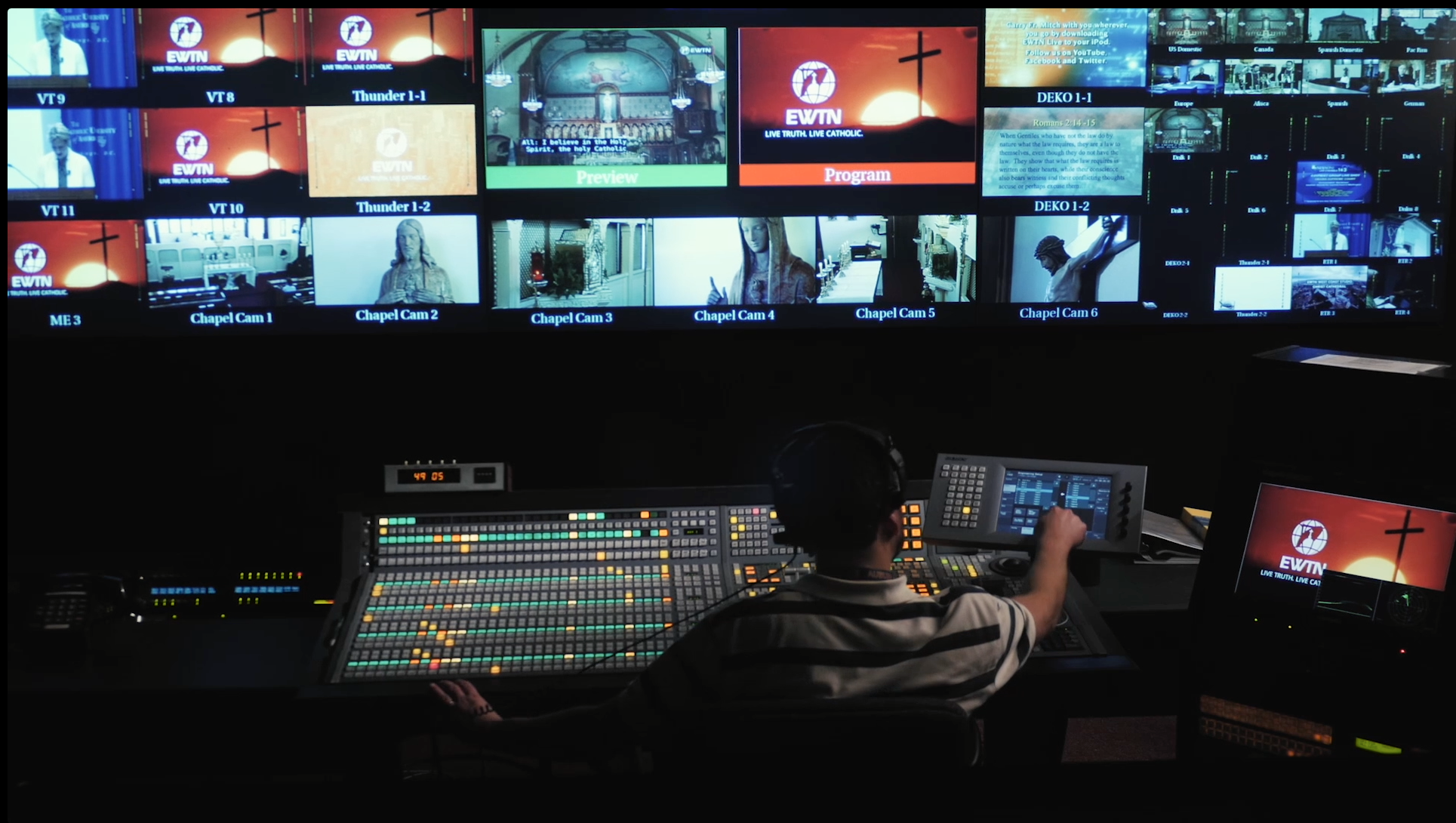
The control room at the EWTN studios in Irondale, Alabama. (Courtesy of EWTN)
In a series of short videos recorded before her death, EWTN founder Mother Angelica reminisced about the early years of the Catholic television network. In one, the elderly nun opens a scrapbook titled "Mother's Memories" and shares a photo from the August 1981 launch, which included a blessing of the satellite dish.
She explains that the photo, when developed, came out with a reddish-orange "flame" emanating from the middle of the dish toward the sky. To her, it "looked like God's approval, like this whole network was going to reach up into heaven."
Mother Angelica regularly attributed the success of EWTN to God's providence, but the history of the operation reveals savvy business decisions that helped "this miracle of God" to become the multi-million-dollar global media conglomerate it is today. That those decisions were made by a woman without much previous power in the church is notable.
"Mother Angelica was both a product of Vatican II and a reaction to Vatican II," said Raymond Haberski, professor of history and American studies at Indiana University-Purdue University in Indianapolis and author of "Evangelization to the Heart," a history of Franciscan media that includes a chapter about Mother Angelica and EWTN.
Following Vatican II's call to engage with the world, she used contemporary media to reach out to mainstream lay Catholics, but eventually realized she could get more mileage by appealing to the politics of those on the right, as Protestant evangelical TV personalities and some secular stations were successfully doing, according to Haberski.
"It's interesting to see EWTN go from being in line with the bishops to a more overt political mission, as media itself developed into being more partisan," Haberski told NCR. "Of course, Americans have always used religion to understand their political landscape. Mother Angelica just gave them another way to do so."
Culture warrior
The habited, feisty Mother Mary Angelica of the Annunciation ("Mother Angelica" for short) emerged as a culture warrior in the mid-1990s, just as battle lines were being drawn in the church and broader U.S. culture.
Before that, although Mother Angelica occasionally mentioned political issues and criticized feminists, she rarely, if ever, attacked the ecclesiastical hierarchy. The monologues on her signature, one-hour talk show, Mother Angelica Live, had always covered a breadth of topics, but focused mainly on personal moral and spiritual development. During the call-in portion of the show, she acted as a Catholic "Dear Abby," answering questions about straying husbands, Scripture, prayer and devotions.
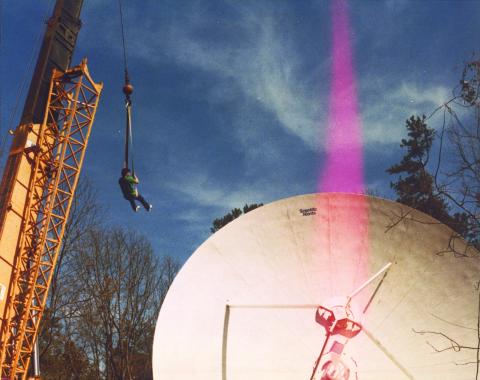
A photo of the satellite dish used in the 1981 launch of EWTN. When developed, the photo came out with a reddish-orange "flame" emanating from the middle of the dish toward the sky. Mother Angelica took this as a sign of God's approval. (Courtesy of EWTN)
Mark Neuhengen, a recent graduate of Loyola University Chicago who watched about 35 hours of the show for an in-depth research project, found early examples of Mother Angelica supporting what could be considered "progressive" causes, such as a just wage (Oct. 8, 1991), and even espousing what some would call a "seamless garment" approach to prolife issues.
"I believe people should vote pro-life, but life is everything: the elderly, the born, the unborn, all of us," she said on Oct. 27, 1992.
But in 1993, during World Youth Day in Denver — in which EWTN's live coverage of the event had already raised its national profile — Mother Angelica exploded over a living Stations of the Cross that featured a female actor for Jesus. In a half-hour tongue-lashing, she excoriated the "liberal church" for this "abomination," and vowed to help take the church back.
"I'm so tired of you, liberal church in America," she said, using the second person to talk directly to those she saw as destroyers of the church over the past 30 years.
"I don't like your church. You have nothing to offer. You do nothing but destroy," she said, adding that "you've been strong too long."
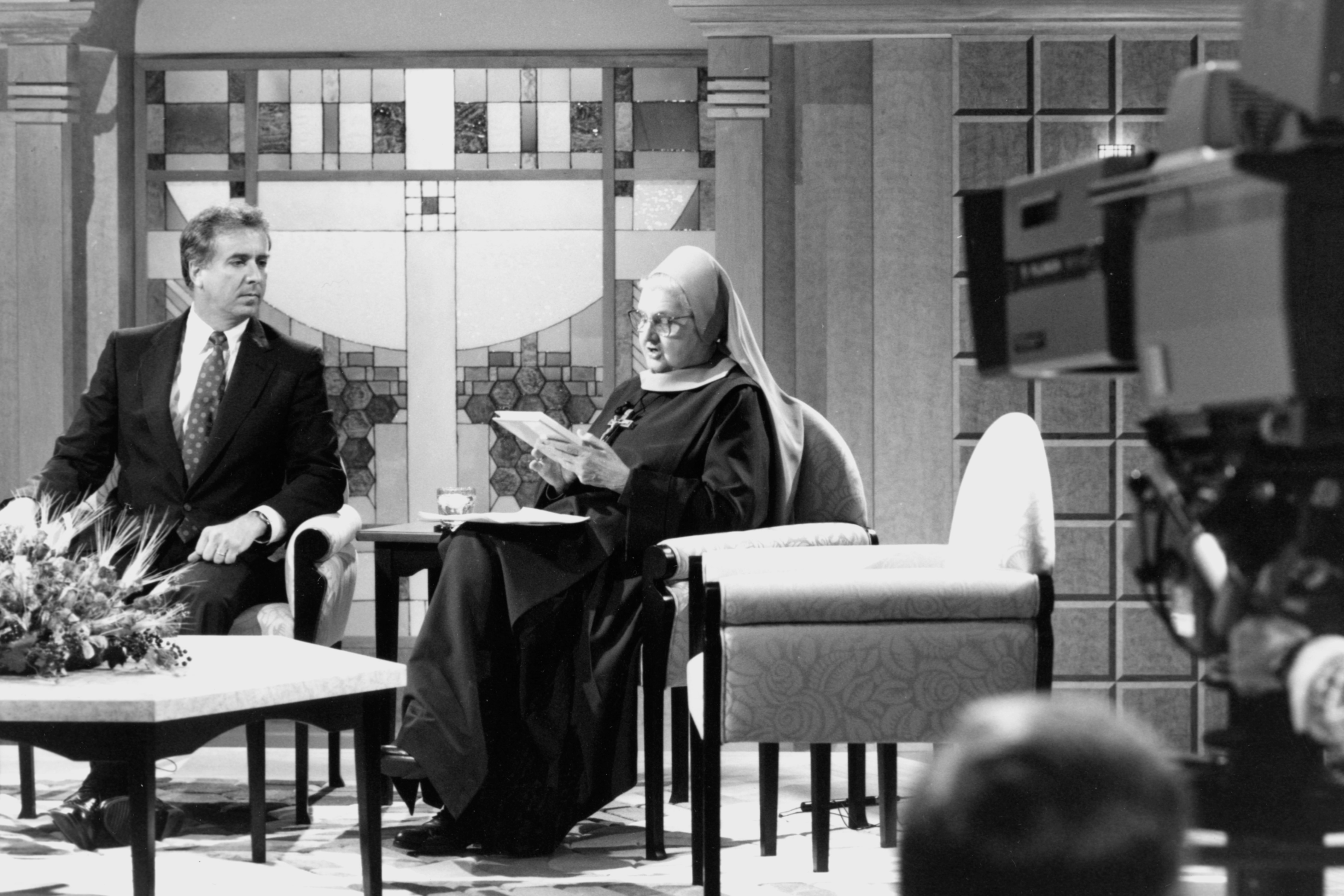
Mother Angelica, founder of the Eternal Word Television Network, on set in a 1992 photo. (CNS files)
Specifically mentioning inclusive language, centering prayer and earth spirituality, she added: "We're just tired of you constantly pushing anti-God, anti-Catholic and pagan ways into the Catholic Church. Leave us alone. Don't pour your poison, your venom, on all the church."
This outburst heralded a new approach, visibly marked by a return to a more traditional habit for Mother Angelica and her order. Claiming she had "a right to be Roman Catholic without your persecution," Mother Angelica took an approach — not dissimilar to previous Catholic media populist Fr. Charles Coughlin — to paint conservative Catholics as the suffering masses against a liberal establishment in the church, said Neuhengen, director of evangelization and parish mission at St. Teresa of Avila Parish in Chicago.
Advertisement
The nun and her network became the guardians of the faith, fighting "this nefarious force in the church that's threatening the faith of the average Catholic," Neuhengen told NCR.
Criticizing the hierarchy was no longer off limits. When Milwaukee Archbishop Rembert Weakland condemned her World Youth Day language as "vitriolic," Mother Angelica responded that"he can go put his head in the back toilet, as far as I am concerned."
A long-running feud with Los Angeles Cardinal Roger Mahony began in 1997 over what she saw as his insufficient emphasis on the Real Presence in his letter on the Eucharist. She said if she lived in his archdiocese she would show "absolutely zero" obedience.
She also had a fight with her local bishop, Bishop David Foley of Birmingham, Alabama, over whether he would celebrate Mass ad orientum (not facing the congregation) in 1999. After consulting with the U.S. bishops, Foley decreed that all Masses in the diocese, including televised ones, must be celebrated facing the people. He prevailed even after a Vatican investigation by Archbishop Roberto Gonzalez, who did an investigation on behalf of the Congregation for the Institutes of Consecrated Life and Societies of Apostolic Life.
But the determined nun had already beaten the U.S. bishops, having built the largest Catholic television network in the world. The U.S. bishops' own Catholic Telecommunications Network of America (CTNA), founded the same year as EWTN, never took off.
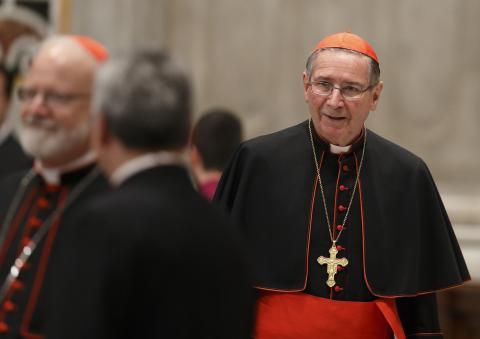
Cardinal Roger M. Mahony, retired archbishop of Los Angeles, is seen at the Vatican in this March 6, 2013, file photo. (CNS photo/Paul Haring)
After little more than a decade and having spent $14 million on the lemon of a project, the bishops voted in 1995 to close CTNA. At that point, they naively believed they could work with Mother Angelica to get their programing on EWTN. But she had fought for her network's independence and was determined to keep it that way.
"The bishops didn't know what to do with her," said Haberski. "First, they ignored her. Then they reacted strongly. Then they tried to figure out how to work with her. But by then, she's so strong, she doesn't need them as much as they need her."
When an official from the bishops' conference complained about EWTN not airing content from or about certain bishops, Mother Angelica reportedly said, "I happen to own the network."
And when the official hinted that she wouldn't be there forever, she retorted, "I'll blow the damn thing up before you get your hands on it," according to an interview with biographer and EWTN anchor Raymond Arroyo.
An influential woman
Few could have predicted that Rita Antoinette Rizzo, Mother Angelica's given name when she was born in 1923 in Canton, Ohio, would go on to become a media mogul whom Time magazine once called "the most influential Roman Catholic woman in America."
She grew up poor and was looked down upon by the nuns in her Catholic school because her parents had divorced after her father had left the family when Rita was a baby. As a young girl, she often worked in her mother's dry cleaning shop, according to the Arroyo biography.
Rizzo was not particularly religious until what she called a miracle healing of severe stomach pain after visiting a mystic and stigmatic in Canton. This experience, she said, led her to religious life. (Her mother would join her as a Poor Clare of the Perpetual Adoration, a contemplative order in the Franciscan tradition, some 20 years later.)
Three years after that first healing, Angelica said she was again miraculously healed from paralysis that was the result of an accident with a floor scrubbing machine. This time she had made a deal with God that she would build a monastery in the South if she could walk again.
To raise money for the project, she and some other sisters started a mail-order fishing lure business, and in 1961, at the invitation of Archbishop Thomas Toolen of the then-Mobile-Birmingham diocese in Alabama, she founded and became abbess of Our Lady of the Angels Monastery in Irondale, which was originally meant to serve African Americans.
In 1987, Mother Angelica also founded a religious order of men, the Franciscan Missionaries of the Eternal Word, dedicated to Catholic communications. The next year, she founded the Knights of the Holy Eucharist, a community of consecrated Franciscan brothers now based in the Diocese of Lincoln, Nebraska.
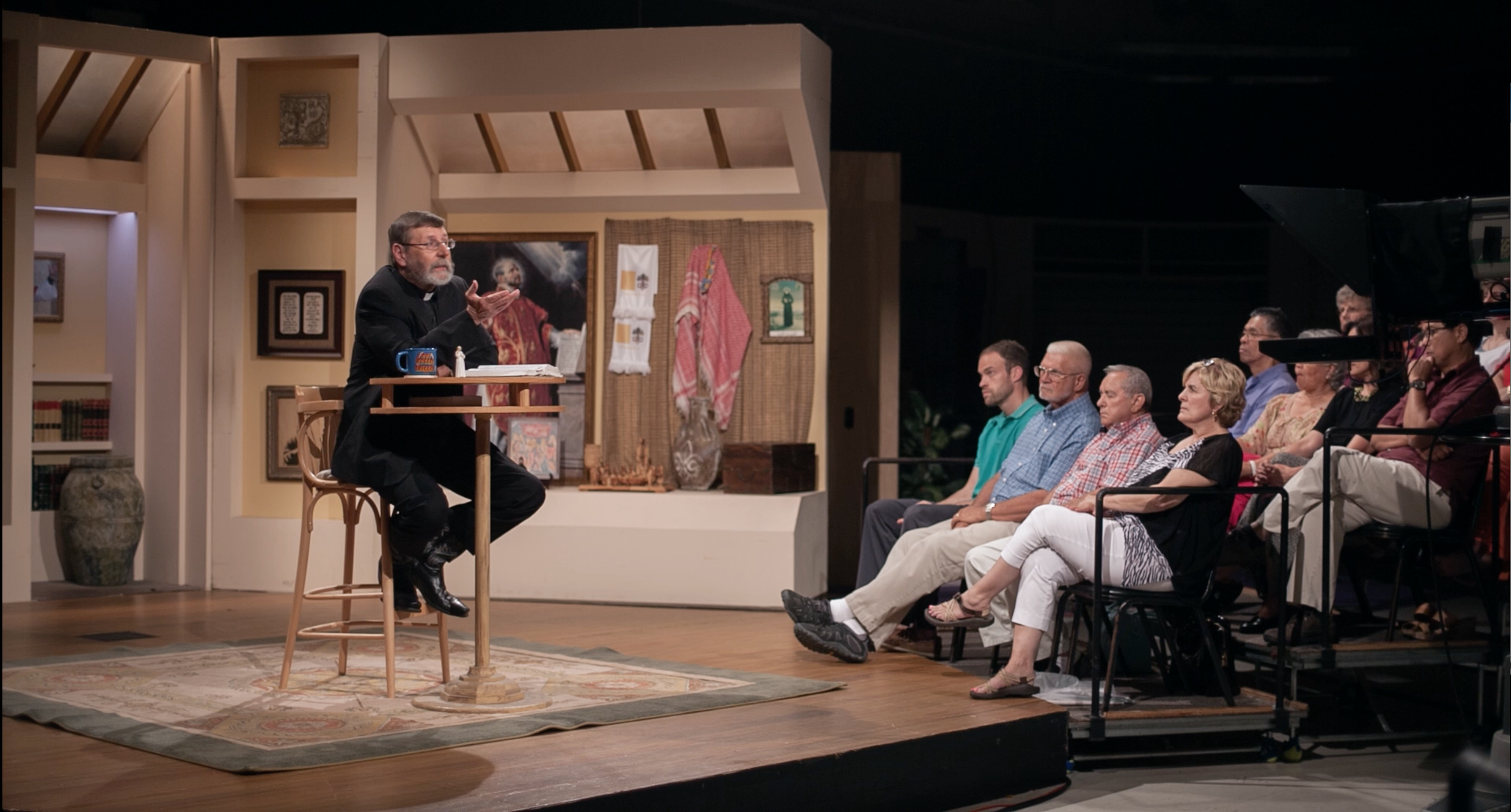
Jesuit Fr. Mitch Pacwa is a frequent host of EWTN television programs. (Courtesy of EWTN)
In 1999, Shrine of the Most Blessed Sacrament of Our Lady of the Angels Monastery — which features a 7-foot monstrance and has become a pilgrimage destination — was completed, thanks to five anonymous donors.
In the beginning, the nuns of the monastery raised money through a peanut business, roasting, packaging and distributing to grocery stores and at the Daytona Race Track. Later, she would tell a story — with her characteristic humor — of how "a concessionaire" tried to pressure her for a kickback, but she refused. "Look, sweetheart, I'm not going to pay," she said, according to the story. "If I'm going to hell, it's not going to be over a peanut."
In the 1970s, Mother Angelica began giving talks, some of which were compiled in pamphlets and books and sold on cassette tapes. She got the idea for a television station after televangelist Pat Robertson's Christian Broadcast Network began airing a series of talks she did for its satellite network.
EWTN's programming has always included Daily Mass and the rosary. It eventually grew to a 24-hour network with in-house-created programming, such as the youth-oriented "Life on the Rock," "The Journey Home" about converts to Catholicism and various shows featuring Jesuit Fr. Mitch Pacwa.
Early on, EWTN received funding from wealthy Catholics anxious to see Catholicism catch up with Protestant evangelical success on TV, according to the Arroyo biography. In 1993 — after a vision of Michael the archangel, Mother Angelica said — EWTN launched its short-wave radio station, WEWN, which transmits to the Caribbean, Central and South America, and Africa. An angel may have pointed out the hilltop where Mother Angelica should build the facility, but it was Piet Derksen, a Dutch leisure-industry billionaire who gave her the money to do it, according to a profile of Mother Angelica in Crisis magazine.
Today EWTN's radio services are transmitted through SIRIUS/XM, iHeart Radio and almost 500 domestic and international AM & FM radio affiliates. Their 11 television networks broadcast in multiple languages to more than 268 million households in more than 145 countries and territories, according to their website.
In 2011, EWTN acquired the National Catholic Register newspaper, the Legion of Christ-owned publication that had been struggling financially in part because of costs related to sexual abuse by the Legion's founder. EWTN also owns two news services, one in English and one in Spanish, including the Denver-based Catholic News Agency. These acquisitions have helped expand EWTN's digital and multimedia presence.
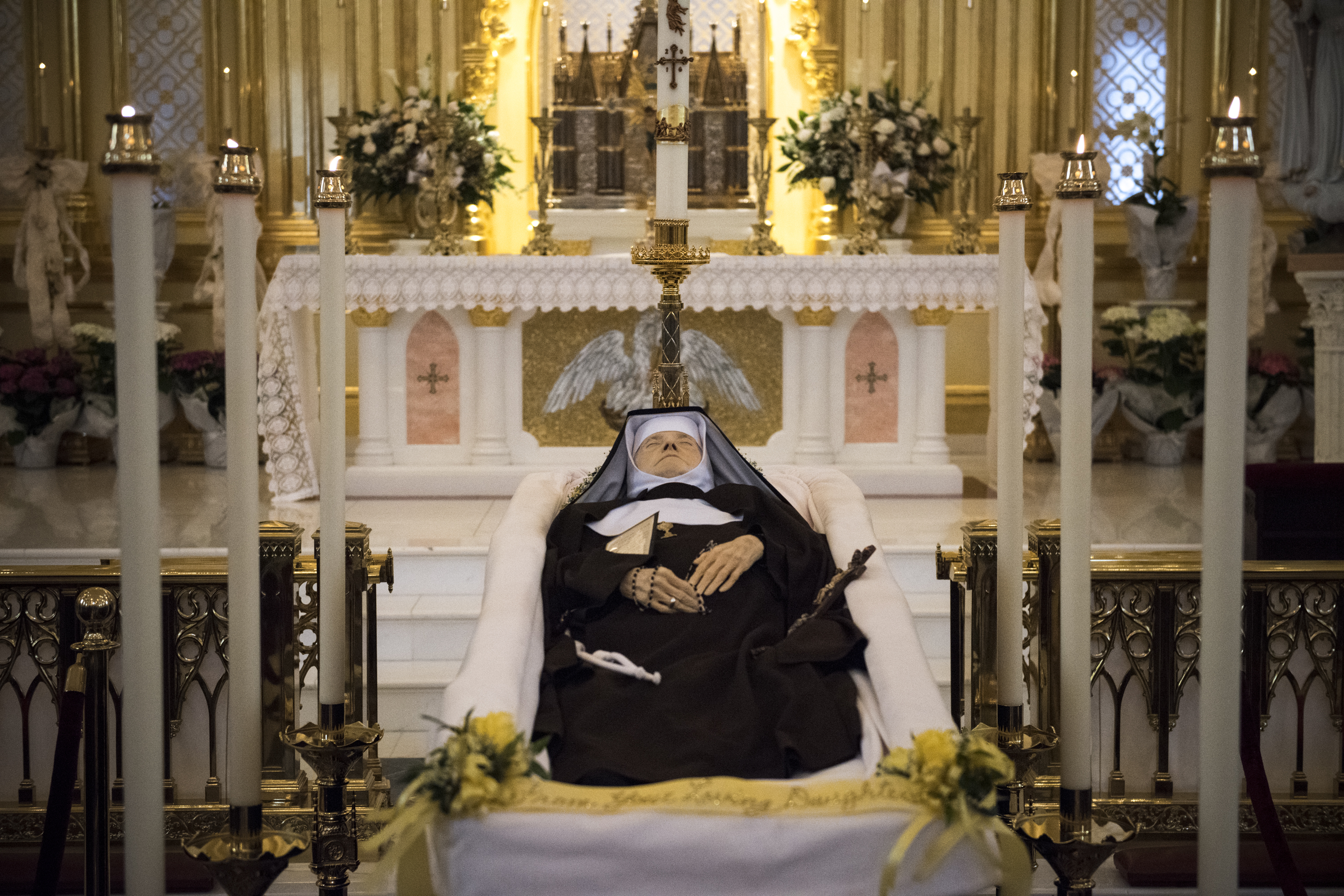
Mother Angelica lies in repose March 29, 2016, at the the Shrine of the Most Blessed Sacrament in Hanceville, Alabama. Five anonymous donors helped build the shrine, which was completed in 1999. (CNS photo/EWTN/Jeff Bruno)
Mother Angelica died on Easter Sunday in 2016 at the age of 92. Some supporters have already been calling for her canonization, although typically there is a five-year waiting period before the process toward sainthood begins.
But 15 years before her death, she had suffered a series of strokes that had incapacitated her and affected her ability to speak. She had resigned as CEO even before that illness, however, shortly after her conflict with the Birmingham bishop and the Vatican investigation, which she feared would result in an ecclesial takeover of the network.
At an emergency St. Patrick's Day board meeting in 2000, EWTN accepted her resignation and amended its corporate bylaws to ensure lay control, which continues today. While some rumors hinted she was forced out and "neutralized" (namely from Christopher Ferrara, whose book "EWTN: A Network Gone Wrong" criticizes the network's direction as too liberal after Mother Angelica's departure), at least one person present at the board meeting says her decision was freely made.
Charles A. Wilson, the retired executive director of the St. Joseph Foundation, which financially supports EWTN, and who later served on EWTN's board of governors, said Mother Angelica resigned but continued to have influence over the network she had built, including membership of the board.
Her promise at that board meeting, Wilson said in a reflection after her death: "I will watch over this network after I retire and I will watch over it after I'm dead."
[Heidi Schlumpf is NCR national correspondent. Her email address is hschlumpf@ncronline.org. Follow her on Twitter @HeidiSchlumpf.]








